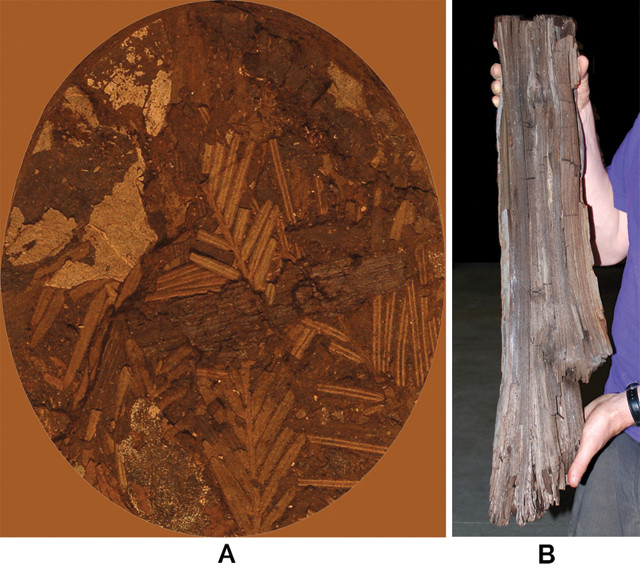
by Lionel Jackson Monday, July 2, 2018

Plant macrofossils from the Ekati Mine, Northwest Territories, Canada, including (A) 50-million-year-old Metasequoia needles and branches, and fossil wood in a 10-centimeter-wide drill core and (B) a large piece of fossil wood containing amber. Credit: courtesy of Alberto Reyes, University of Alberta.
Diamonds mined from the kimberlite pipes of the Lac de Gras diamond field in Northwest Territories, Canada, are among the world’s youngest known diamonds, dating from 75 million to 45 million years ago. In some cases, when the magmas that carried these diamonds to Earth’s surface encountered water-saturated rock at shallow depths, violent steam explosions called phreatomagmatic eruptions resulted. Such explosions can form volcanic craters known as maars, which often fill with water and accumulate lake sediment, along with soil and vegetation that collapse into them from their margins. In the case of the Panda kimberlite pipe at the Ekati Mine in the Lac de Gras area, maar sediments accumulated far below the surrounding terrain, such that they were later buried under glacial deposits rather than being eroded away by ice sheets during the past million years. Wood and other organic materials were entombed and preserved in their natural state, thereby preserving shreds of the Paleo-Bell River Basin.
Diamond mining in the late 1990s inadvertently exposed this paleontological and paleoclimatic treasure trove, which has given scientists insights into the Eocene climate of the northern Bell River Basin and much more. Prominent among the tree species preserved was Metasequoia, commonly known as dawn redwood, which today is native only to Lichuan County in China’s Hubei Province (at about 30 degrees north latitude). In fact, this deciduous cousin to the California redwood was thought to have been extinct for millions of years until living specimens were discovered in the 1940s. Since this discovery, earth and life scientists from Canada, the U.S. and elsewhere have investigated the pollen and macrofossil vegetation — as well as oxygen and hydrogen isotopic ratios in cellulose and amber within well-preserved wood — recovered from the maar fill. The isotopic ratios provide proxy data for average annual temperatures and rainfall through part of the early Eocene, when the Paleo-Bell River system would’ve been flowing across much of North America — valuable information to climate scientists trying to model and understand the effects of elevated carbon dioxide levels in past and future climates. The scientists found that early Eocene temperatures near Lac de Gras were 12 to 17 degrees Celsius warmer than today and that four times as much precipitation fell — conditions not unlike those near the Yangtze River where Metasequoia grows today.
© 2008-2021. All rights reserved. Any copying, redistribution or retransmission of any of the contents of this service without the expressed written permission of the American Geosciences Institute is expressly prohibited. Click here for all copyright requests.